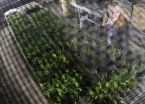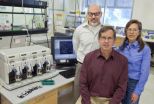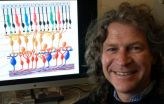(Press-News.org) Urban search and rescue (USAR) task forces are essential for locating, stabilizing, and extricating people who become trapped in confined spaces following a catastrophic event. Sometimes the search area is too unstable for a live rescue team, so rescuers have turned to robots wielding video cameras. Most recently, the USAR robots have been employed by rescuers following the devastating Japanese earthquake and tsunami. The rescuers control, or teleoperate, from a safe location. Teleoperation can be problematic, as robots frequently become stuck, which can destabilize the search area and hinder rescue operations.
"The World Trade Center site was the first major real-world evaluation of robots as tools for USAR," says Keith Jones, an HF/E researcher at Texas Tech University. "Overall, the robots performed well. One problem that did surface, however, was that the robots got stuck, a lot." Jones, with coauthors Brian Johnson and Elizabeth Schmidlin, published a study of USAR robot teleoperation in a special issue of the Journal of Cognitive Engineering and Decision Making on human-robot interaction.
In a series of experiments, Jones and colleagues asked participants to drive a USAR robot through the openings of various structures. Successful navigation through openings depended on the size of the robot and the operator's level of driving skill. Results indicated that, surprisingly, untrained operators could accurately judge the robot's size relative to the opening. However, operators perceived their skill at guiding the USAR robot through the opening as greater than their performance demonstrated. This judgment factors in the size of the robot, the operator's driving skill, and the size of the aperture. Jones et al. did find that, with practice, participants improved their driveability judgments.
"Our research seeks to understand why operators are getting their robots stuck," says Jones. "With that knowledge, hopefully, we can reduce the problem, and increase the amount of time that operators spend searching for survivors."
###
For a full copy of the article, go to http://edm.sagepub.com/content/5/1/10.full.pdf+html or contact HFES Communications Director Lois Smith (lois@hfes.org, 310/394-1811).
The Human Factors and Ergonomics Society is the world's largest nonprofit individual-member, multidisciplinary scientific association for human factors/ergonomics professionals, with more than 4,500 members globally. HFES members include psychologists and other scientists, designers, and engineers, all of whom have a common interest in designing systems and equipment to be safe and effective for the people who operate and maintain them. Watch science news stories about other HF/E topics at the HFES Web site. "Human Factors and Ergonomics: People-Friendly Design Through Science and Engineering"
Plan to attend the HFES 55th Annual Meeting, September 19-23: http://www.hfes.org/web/HFESMeetings/2011annualmeeting.html
Photo Credit: National Institute of Standards and Technology
Practice can make search-and-rescue robot operators more accurate
Study finds that untrained operators often misjudge their expertise in navigating robots through openings while searching for survivors
2011-05-08
ELSE PRESS RELEASES FROM THIS DATE:
Robot based on Carnegie Mellon research engages novice computer scientists
2011-05-08
PITTSBURGH—Learning how to program a computer to display the words "Hello World" once may have excited students, but that hoary chestnut of a lesson doesn't cut it in a world of videogames, smartphones and Twitter. One option to take its place and engage a new generation of students in computer programming is a Carnegie Mellon University-developed robot called Finch.
A product of CMU's famed Robotics Institute, Finch was designed specifically to make introductory computer science classes an engaging experience once again.
A white plastic, two-wheeled robot with bird-like ...
Short antibiotic courses safer for breathing-tube infections in children
2011-05-08
Short courses of antibiotics appear just as effective as longer ones
- and a great deal safer - in treating respiratory infections that might cause pneumonia in children on temporary breathing devices, according to a Johns Hopkins Children's Center study published online May 3 in Clinical Infectious Diseases.
In the study's analysis of 150 children treated with antibiotics for respiratory infections while on a ventilator, longer antibiotic courses did not only fail to confer extra protection against full-blown pneumonia when compared with shorter therapy, but also considerably ...
Selaginella genome adds piece to plant evolutionary puzzle
2011-05-08
WEST LAFAYETTE, Ind. - A Purdue University-led sequencing of the Selaginella moellendorffii (spikemoss) genome - the first for a non-seed vascular plant - is expected to give scientists a better understanding of how plants of all kinds evolved over the past 500 million years and could open new doors for the identification of new pharmaceuticals.
Jody Banks, a professor of botany and plant pathology, led a team of about 100 scientists from 11 countries to sequence the genome of Selaginella, a lycophyte. Lycophytes, which are the oldest living vascular plants, shed spores ...
Wistar researchers: Direct proof of how T cells stay in 'standby' mode
2011-05-08
For much of the time our T cells—the white blood cells that act as the police of the immune system—are in what immunologists call a "quiescent state," a sort of standby mode. For years, scientists have wondered if quiescence occurred by default or whether T cells need to work at remaining silent. Now, researchers at The Wistar Institute provide the first direct proof that a protein, called Foxp1, actively maintains this state of quiescence in T cells until the cells are called upon by other parts of the immune system.
Their findings, which appear online through Nature ...
It takes a community of soil microbes to protect plants from disease
2011-05-08
Those vegetables you had for dinner may have once been protected by an immune system akin to the one that helps you fight disease. Scientists from the U.S. Department of Energy's Lawrence Berkeley National Laboratory (Berkeley Lab) and the Netherland's Wageningen University found that plants rely on a complex community of soil microbes to defend themselves against pathogens, much the way mammals harbor a raft of microbes to avoid infections.
The scientists deciphered, for the first time, the group of microbes that enables a patch of soil to suppress a plant-killing pathogen. ...
Antibodies help protect monkeys from HIV-like virus, NIH scientists show
2011-05-08
WHAT:
Using a monkey model of AIDS, scientists have identified a vaccine-generated immune-system response that correlates with protection against infection by the monkey version of HIV, called simian immunodeficiency virus (SIV). The researchers found that neutralizing antibodies generated by immunization were associated with protection against SIV infection. This finding marks an important step toward understanding how an effective HIV vaccine could work, according to scientists who led the study at the National Institute of Allergy and Infectious Diseases (NIAID), part ...
Anatomy of an outbreak
2011-05-08
GALVESTON, Texas — What causes a virus to suddenly begin infecting large numbers of people?
Scientists have long known that the process they call "viral emergence" involves a wide variety of factors. Some are changes in the environment, either generated by natural causes or human activity. Others are internal, arising from accidental changes — mutations —in the virus' genetic code.
Studying such mutations in different strains of the chikungunya virus has helped University of Texas Medical Branch researchers solve one of the most puzzling mysteries of chikungunya's ...
Forecast calls for nanoflowers to help return eyesight
2011-05-08
EUGENE, Ore. -- University of Oregon researcher Richard Taylor is on a quest to grow flowers that will help people who've lost their sight, such as those suffering from macular degeneration, to see again.
These flowers are not roses, tulips or columbines. They will be nanoflowers seeded from nano-sized particles of metals that grow, or self assemble, in a natural process -- diffusion limited aggregation. They will be fractals that mimic and communicate efficiently with neurons.
Fractals are "a trademark building block of nature," Taylor says. Fractals are objects with ...
DNA from common stomach bacteria minimizes effects of colitis, U-M study says
2011-05-08
ANN ARBOR, Mich. — DNA from Helicobacter pylori, a common stomach bacteria, minimizes the effects of colitis in mice, according to a new study by University of Michigan Medical School scientists.
The study published in Gut this month was performed by a team of investigators assembled by senior author John Y. Kao, M.D. of the University of Michigan's Division of Gastroenterology and assistant professor in U-M's Department of Internal Medicine. The findings indicate that DNA from H. pylori significantly ameliorates the severity of colitis, say lead authors Jay Luther, M.D. ...
When self-esteem is threatened, people pay with credit cards
2011-05-08
Los Angeles, CA - People shop for high status items when they're feeling low, and they're more likely to make those expensive purchases on credit, according to a study in the current Social Psychological and Personality Science (published by SAGE).
When a person's ego is threatened—by doing poorly on a task, by being told they're not as good as they hoped—people sometimes repair their self-worth by purchasing luxury goods. Because actually parting with cash can be psychologically painful, researchers Niro Sivanathan of the London Business School and Nathan Pettit of Cornell ...
LAST 30 PRESS RELEASES:
Numbers in our sights affect how we perceive space
SIMJ announces global collaborative book project in commemoration of its 75th anniversary
Air pollution exposure and birth weight
Obstructive sleep apnea risk and mental health conditions among older adults
How talking slows eye movements behind the wheel
The Ceramic Society of Japan’s Oxoate Ceramics Research Association launches new international book project
Heart-brain connection: international study reveals the role of the vagus nerve in keeping the heart young
Researchers identify Rb1 as a predictive biomarker for a new therapeutic strategy in some breast cancers
Survey reveals ethical gaps slowing AI adoption in pediatric surgery
Stimulant ADHD medications work differently than thought
AI overestimates how smart people are, according to HSE economists
HSE researchers create genome-wide map of quadruplexes
Scientists boost cell "powerhouses" to burn more calories
Automatic label checking: The missing step in making reliable medical AI
Low daily alcohol intake linked to 50% heightened mouth cancer risk in India
American Meteorological Society announces Rick Spinrad as 2026 President-Elect
Biomass-based carbon capture spotlighted in newly released global climate webinar recording
Illuminating invisible nano pollutants: advanced bioimaging tracks the full journey of emerging nanoscale contaminants in living systems
How does age affect recovery from spinal cord injury?
Novel AI tool offers prognosis for patients with head and neck cancer
Fathers’ microplastic exposure tied to their children’s metabolic problems
Research validates laboratory model for studying high-grade serous ovarian cancer
SIR 2026 delivers transformative breakthroughs in minimally invasive medicine to improve patient care
Stem Cell Reports most downloaded papers of 2025 highlight the breadth and impact of stem cell research
Oxford-led study estimates NHS spends around 3% of its primary and secondary care budget on the health impacts of heat and cold in England
A researcher’s long quest leads to a smart composite breakthrough
Urban wild bees act as “microbial sensors” of city health.
New study finds where you live affects recovery after a hip fracture
Forecasting the impact of fully automated vehicle adoption on US road traffic injuries
Alcohol-related hospitalizations from 2016 to 2022
[Press-News.org] Practice can make search-and-rescue robot operators more accurateStudy finds that untrained operators often misjudge their expertise in navigating robots through openings while searching for survivors


